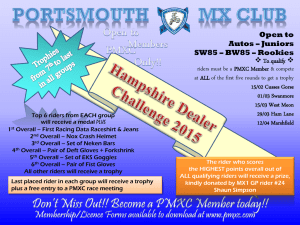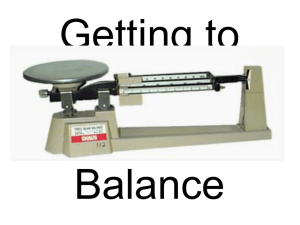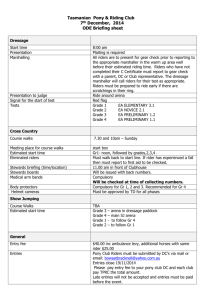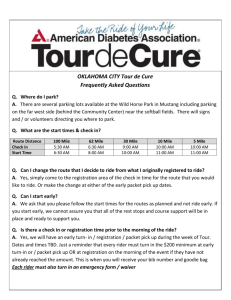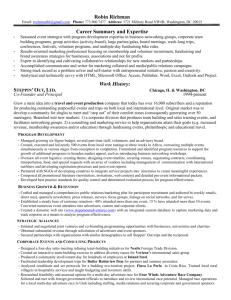Ipswich-Bicycle-Club-Club-Ride-Code-of
advertisement
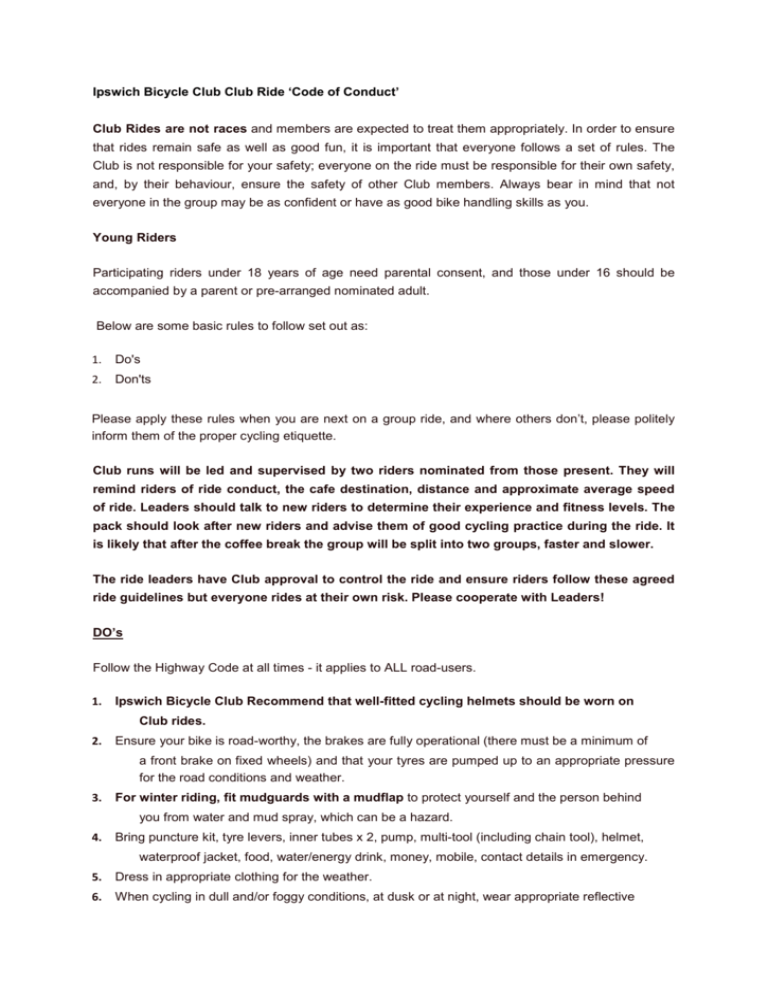
Ipswich Bicycle Club Club Ride ‘Code of Conduct’ Club Rides are not races and members are expected to treat them appropriately. In order to ensure that rides remain safe as well as good fun, it is important that everyone follows a set of rules. The Club is not responsible for your safety; everyone on the ride must be responsible for their own safety, and, by their behaviour, ensure the safety of other Club members. Always bear in mind that not everyone in the group may be as confident or have as good bike handling skills as you. Young Riders Participating riders under 18 years of age need parental consent, and those under 16 should be accompanied by a parent or pre-arranged nominated adult. Below are some basic rules to follow set out as: 1. Do's 2. Don'ts Please apply these rules when you are next on a group ride, and where others don’t, please politely inform them of the proper cycling etiquette. Club runs will be led and supervised by two riders nominated from those present. They will remind riders of ride conduct, the cafe destination, distance and approximate average speed of ride. Leaders should talk to new riders to determine their experience and fitness levels. The pack should look after new riders and advise them of good cycling practice during the ride. It is likely that after the coffee break the group will be split into two groups, faster and slower. The ride leaders have Club approval to control the ride and ensure riders follow these agreed ride guidelines but everyone rides at their own risk. Please cooperate with Leaders! DO’s Follow the Highway Code at all times - it applies to ALL road-users. 1. Ipswich Bicycle Club Recommend that well-fitted cycling helmets should be worn on Club rides. 2. Ensure your bike is road-worthy, the brakes are fully operational (there must be a minimum of a front brake on fixed wheels) and that your tyres are pumped up to an appropriate pressure for the road conditions and weather. 3. For winter riding, fit mudguards with a mudflap to protect yourself and the person behind you from water and mud spray, which can be a hazard. 4. Bring puncture kit, tyre levers, inner tubes x 2, pump, multi-tool (including chain tool), helmet, waterproof jacket, food, water/energy drink, money, mobile, contact details in emergency. 5. Dress in appropriate clothing for the weather. 6. When cycling in dull and/or foggy conditions, at dusk or at night, wear appropriate reflective bright clothing and ensure you have working lights on the front and rear of your bike and use them. 7. When conditions permit, cycle a maximum of two abreast in close parallel lines, focus on keeping it neat and tidy. If the group size is over 12 people, the riders will be split into two groups and ride at least 150 metres apart at all times. 8. Ride directly behind the rider in front of you, with a minimum of 60cms between your front wheel and the back wheel of the rider in front. There should also be about 30-45cms between your shoulders and the rider beside you. 9. Lead cyclists to navigate and point out hazards in the road by either shouting or using hand signals, preferably both. Listen to them and act on the calls, and most importantly, repeat them for the cyclist behind you. 10. Be prepared on small or busy roads to ride in single file; the inside rider at front to speed up to create space for outside riders to pull into the inside. There should be no need to brake whilst singling out. 11. Riders at the back of the pack to shout "Car behind, single file" if there are vehicles behind. Listen and act on their call, DON'T look back and check for yourself, as you will move off your line and may cause an accident. Transmit the call forward through the Group. 12. Ride directly behind the wheel of the rider in front. If the inside rider cycles in the middle of the two wheels in front of you, you WILL push the cyclist on your outside into the path of passing vehicles. 13. Cover your brakes when appropriate but always when in close formation. 14. Brake as gently and smoothly as you safely can when riding in a pack, calling out “Slowing” or “Stopping.” 15. When on the front keep pedalling, this is particularly important going downhill. If you freewheel everyone behind may have to brake. 16. Talk to each other. But don’t lose concentration on what is happening around you. Point out with hand signals and shouts, all potholes, manhole covers and other dangers in the road that could cause a puncture or an accident. Follow the hand signals and calls of the riders in front as they will have seen the danger before you, and then you must communicate down the pack. 17. If you are at the back of the group and you, or someone else is being dropped, it is your responsibility to call to the cyclists in front that the pace is too high. The pack must communicate this up to the front. The lead cyclists will not be aware if you start to drop off. Ask them to slow down; it is your ride too. 18. When asked to “ease up’ or “slow a little” do not brake suddenly. Gently ease your pace by pedalling less hard or freewheeling for a moment. Look at your speedo - if someone is being dropped you probably only need to reduce your speed by one mile an hour to allow them to stay on. 19. Keep the pace smooth and constant, keeping the pack as a compact unit. 20. Check over your shoulder for other riders or traffic before moving out to the right 21. Slow right down when passing horses, and pass them as wide as it is safe to do so. Always call to the horse riders well ahead of catching them - a cheery “Good morning” or “Hello”. Keep calling until the riders indicate they know you are there. They may want to turn the horse so it can see you. 22. If you are on the front, remember that people are following your calls. Stop at T junctions and only pull out when it is safe for the whole group to make the move. If you decide to pull out on a roundabout or junction, you need to call "Clear", - or "Wait" - to warn the pack of hazards. 23. If you are feeling tired let people know. Accidents happen when people are tired and lose concentration. Everyone gets tired, let people know so they can slow the pace down and tuck you in the pack to get you home. 24. Cycle with confidence. If you're nervous you will tense up and then are less likely to be able to respond to things quickly. 25. If you puncture, shout “Puncture”. Ease down slowly, so the rider behind does not hit you. Get your bike off the road to replace the tube. The group will stop and wait for you. Other bikes and riders must not impede the flow of traffic. 26. Actively encourage fellow riders to follow these guidelines during every ride. DON’Ts 1. Don’t overlap wheels, or nudge in between the wheels of the riders in front. You may come off If they move off their line. 2. Don’t ride on tri / aero bars in packs as you will not be able to brake or steer quickly, and don’t wear earphones as you won’t be able to hear warning shouts. 3. Don’t make any sudden movements/changes in direction off your line when in the pack. You are responsible for the cyclist behind you, they are following YOUR wheel, they need to trust you. 4. Don’t ride off the front. This is a group ride, not a race. If you want to go faster then let the others know what you are going to do and if no one wants to join you then go off and enjoy your ride alone. Under no circumstances should phone apts such as Strava be used on club rides. 5. Don’t stop pedalling if you are on the front, even downhill. The cyclists behind you may read this as you slowing and could be forced to brake and bunch up. 6. Don’t focus only on the wheel in front. Keep aware of everything that is going on around you, look ahead and that way you can avoid most hazards. 7. Don’t whip round the outside of the pack to get to the front unless in an emergency. Shout up the pack any communication. If you do need to get to the front then make sure you check in front and behind for cars, remember three abreast will push you out into oncoming traffic. 8. Don’t pull out at junctions without looking, having heard the "Clear" call from a fellow cyclist. Look to see if there is a vehicle coming before you pull out. 9. Don’t take a detour, go home, or ride on at the café, without telling the ride leader 10. Don’t speed up on hills. If you climb faster than others, wait at the top to regroup 11. Don’t sprint for road signs. The Club advises against the long-held practice of sprinting for road signs, due to current traffic density, large group sizes and other safety factors. If you need to train for sprinting, do it on your own, or with a Club mate, and only where conditions allow. 12. Don’t be tempted to wave on drivers of following vehicles; let the driver make his/her own decision to pass when it is safe to do so. 13. Don’t take toilet breaks in full view of the public, or riders of the opposite sex in your Group. BE CONSIDERATE AND DISCRETE ! The Club recommends that anyone who rides on public roads has appropriate Third Party, Cycling Insurance cover (e.g. as provided by the BTA/ BC/CTC). Also consider Personal Accident Insurance cover
